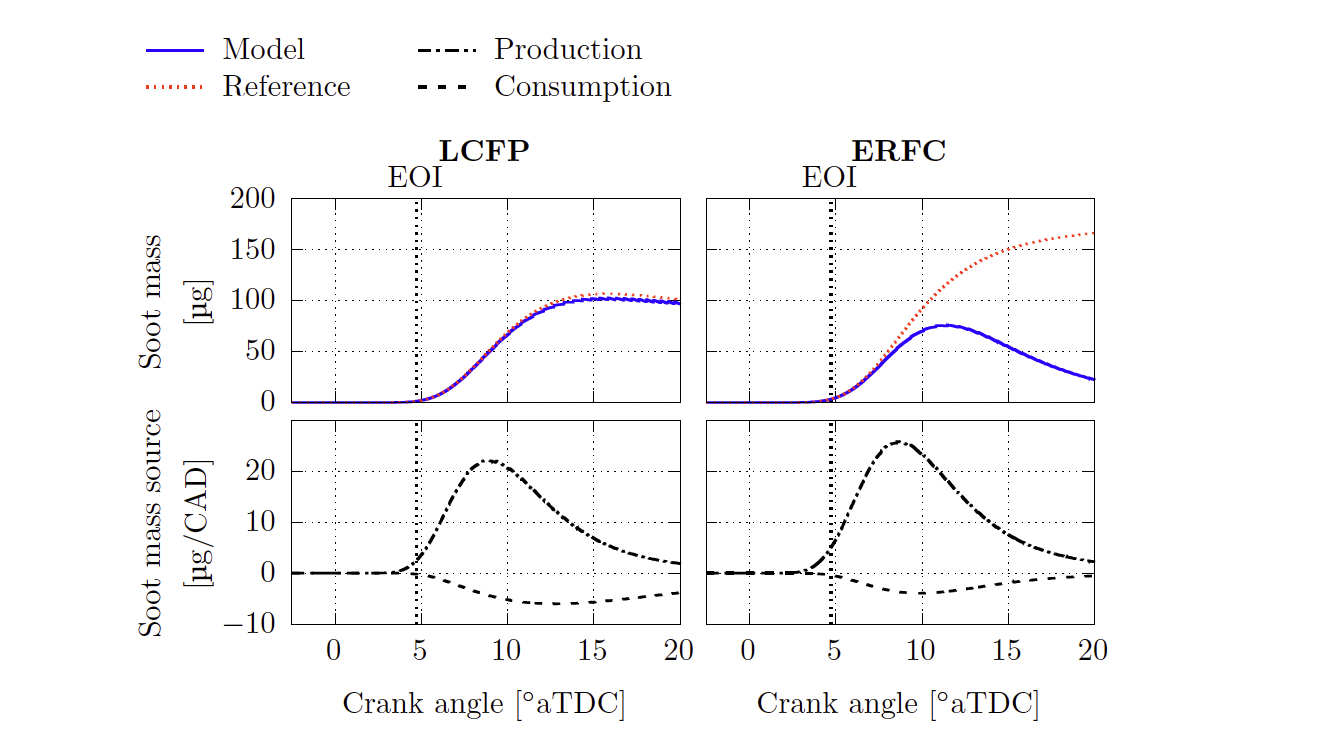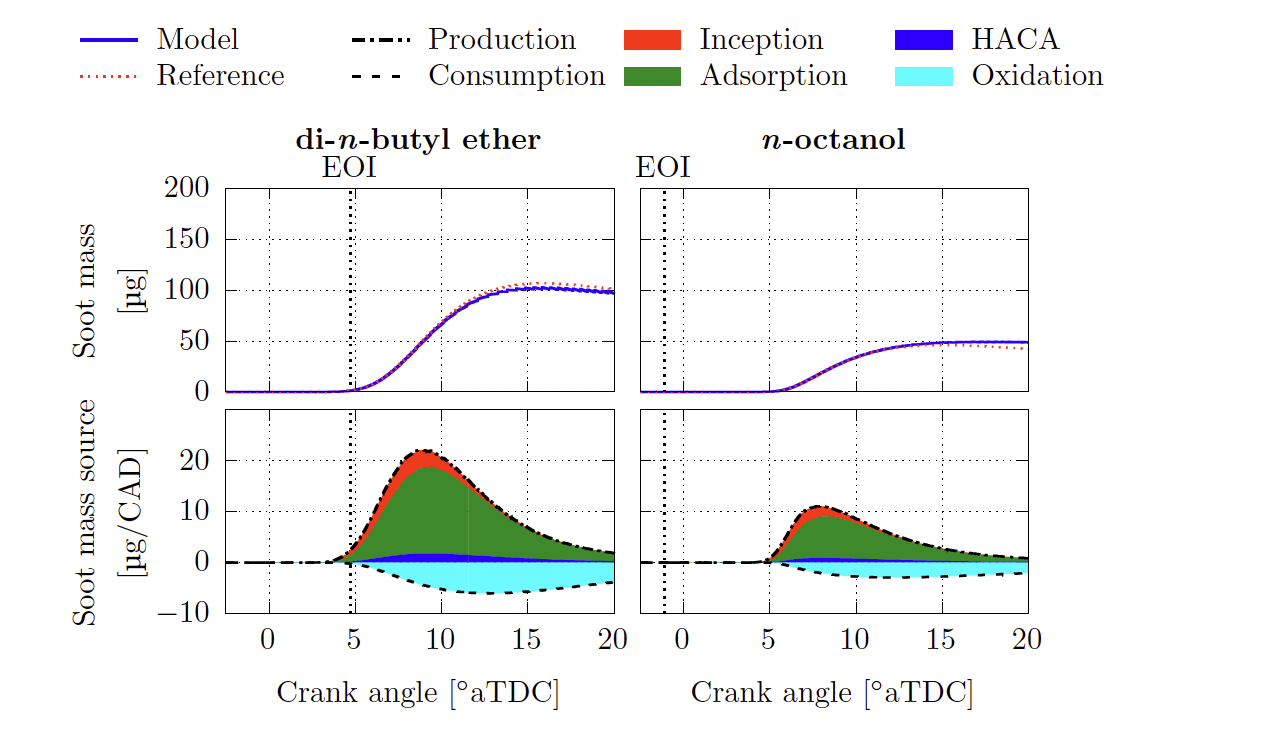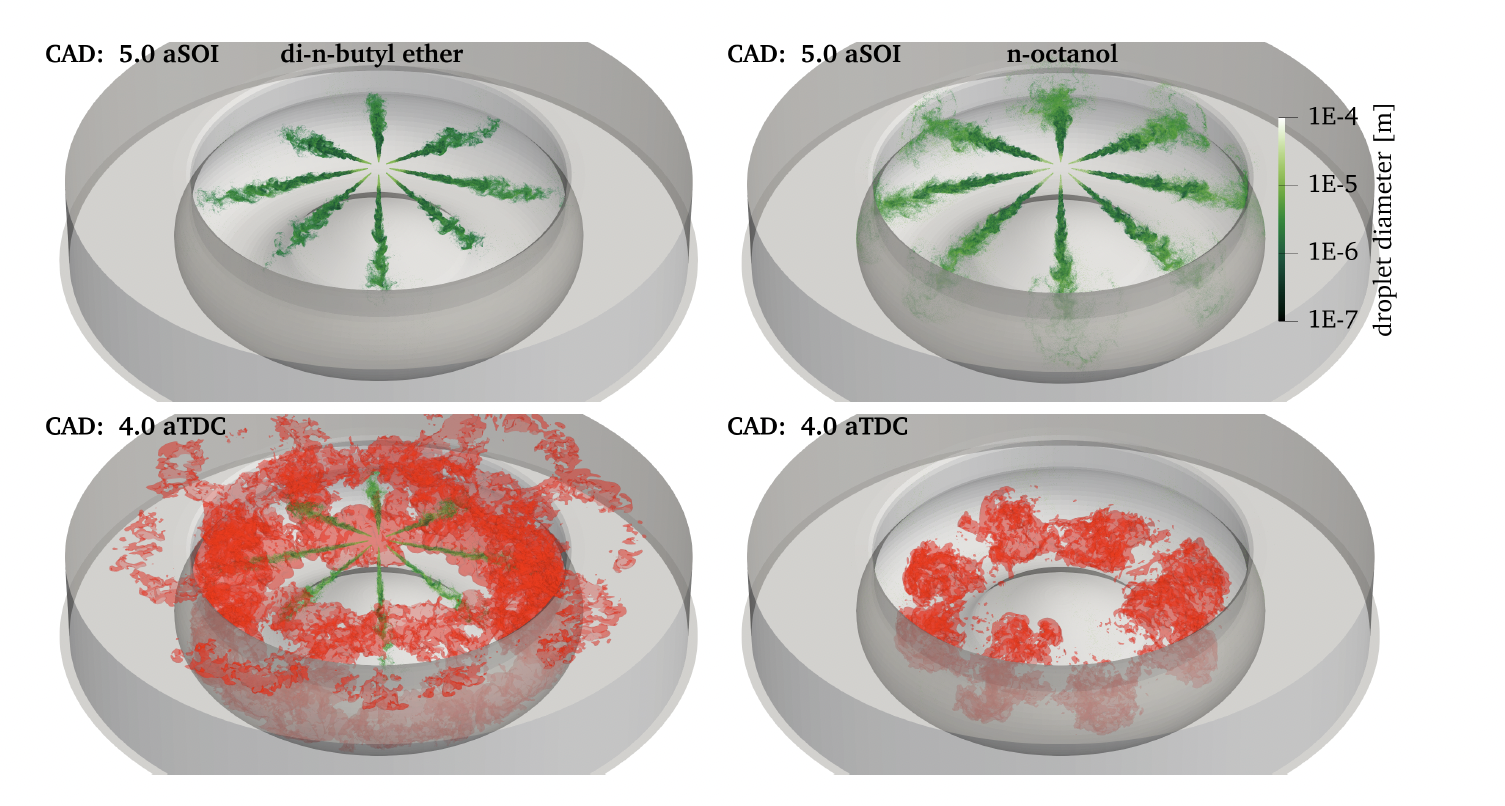Project
Pollutant Formation of Alternative Fuels in Compression Ignition Engines
Alternative fuels hold signifixcant potential for reducing net greenhouse gas emissions due to their closed carbon cycle. However, harmful pollutants such as nitrogen oxides and soot can still form during combustion. Minimizing these pollutant emissions is crucial, given the high costs associated with exhaust gas after-treatment systems. Optimizing fuel composition or engine design is challenging due to the complexity of these systems. High- delity simulations can complement detailed experimental investigations by providing information that is not experimentally accessible, thereby enhancing our understanding of the underlying processes and causal relationships. This project aimed to investigate how fuel structure a ects pollutant formation. We conducted large eddy simulations (LES) of engine-internal combustion and pollutant
formation for Di-n-butyl ether (DnBE) and 1-octanol and studied the in-cylinder soot formation process. These fuels are particularly interesting because they share the same molecular composition but di er in molecular structure, leading to distinct behaviors in mixture formation, combustion, and pollutant formation. In order to study the in-cylinder soot formation process, the existing turbulent combustion model has been revised within this project. A mathematically consistent transport formulation has been derived for mixture fraction-based combustion models. The model has been implemented and applied to various flow configurations in order to assess the importance of the model revision as well as the e ect of numerical errors on the conservation properties.
Project Details
Project term
March 1, 2023–March 9, 2024
Affiliations
RWTH Aachen University
Institute
Institute for Combustion Technology (ITV)
Project Manager
Principal Investigator
Methods
“The filtered Navier-Stokes equations were solved on a structured staggered Cartesian grid employing distributed memory parallelization using the Message Passing Interface (MPI) standard along Cartesian partitions. For spatial discretization, second-order cen- tral differences were employed, except for the scalar convective terms, which were ap- proximated using WENO5 schemes. Time integration was performed using an explicit low-storage five-stage Runge-Kutta (RK) method with second-order accuracy. The fuel spray was modeled using a Lagrangian Particle Tracking (LPT) approach. The Lagrangian particles were advanced using a second-order RK method with adaptive time-stepping. These particles were solved by MPI processes that also own the data of the surrounding gas flow field. To account for turbulence-chemistry interactions, the Multiple Representative Interac- tive Flamelet (MRIF) combustion model was used. This model solves for the mixture fraction statistics in physical space, while the chemistry is parameterized over the mix- ture fraction. Diffusive terms were discretized using second-order central differences, and first-order upwind schemes were used for convection. The time integration in mixture fraction space was performed using the MPI-parallelized implementation of the CVODE solver, with parallelization applied along the mixture fraction grid. Recent findings indicate that scalar transport in mixture fraction space must be formu- lated consistently with the transport of mixture fraction statistics in physical space to prevent scalar mass conservation errors. In this project, a new mathematically consistent model, the Local Consistent Flow Parameters (LCFP) model, was derived, implemented, and applied to different flow configurations.”
Results
This section presents the results of the in-cylinder LES. Note that high-pressure chamber simulations have also been performed within this project, but the results are not shown here for brevity. The DNBE case is simulated using both the LCFP model and a conventional model (ERFC), while the n-octanol case is investigated solely with the LCFP model. The top plots in Fig. 1 compare the in-cylinder soot mass evolution obtained for the LCFP model (left) and the ERFC model (right) in the DNBE case. Note that the red dotted lines illustrate reference solutions that are not contaminated by transport conser- vation errors. Thus, the difference between the solid blue and dotted red lines illustrates soot mass conservation errors. It can be seen that the conventional model is prone to soot mass conservation errors, while the LCFP model shows only small conservation er- rors, which have been attributed to numerical errors and the negligence of inter-flamelet mixing effects. The bottom plots of Fig. 1 depict the corresponding volume-integrated soot production and consumption rates, which shows that the total soot mass decreases when using the conventional ERFC model even though soot production is larger than soot consumption at all times. The total soot mass evolution predicted for both fuels is compared in the upper plots of Fig. 2. The LES results align with previous findings from optical engine experiments; DNBE initially exhibits strong soot formation, reaching a higher intermediate soot mass peak than n-octanol. The upper right plot of Fig. 2 additionally shows that the conser- vation errors are also small in the n-octanol case. The simulated total soot production and consumption, along with the contributions of individual soot formation processes, are illustrated in the bottom plots of Fig. 2. Initially, it is observed that DNBE has overall higher production and consumption rates than n- octanol, while the relative contributions of the individual formation pathways are similar for both fuels. The majority of soot is predicted to form through PAH-based growth, while the contribution of the HACA mechanism is small. Moreover, it is noteworthy that the soot production peaks earlier for n-octanol than for DNBE, and the production declines more rapidly for DNBE than for n-octanol.
Figure 4: Visualization of in-cylinder spray and combustion for DNBE (left) and
n-octanol (right). Liquid fuel droplets and fuel vapor isosurface are shown in
green, OH* isosurface is shown in cyan, and the color scale corresponds to
di erent soot volume fraction isosurfaces.
Discussion
A revised LES engine model was applied to a compression ignition engine case. The two alternative fuel candidates DNBE and
n-octanol were considered, which have the same molecular composition but strongly differ in fuel properties due to their distinct molecular structures. The in-cylinder combustion and soot formation process were investigated, demonstrating that the revised model aligns better with experimental data, particularly for soot. General trends that were observed in past experiments have been captured. The simulation results further suggest that the differences in PM emissions observed in experiments for the considered operating point are primarily attributed to differences in cetane number (CN) and the correspondingly adjusted injection timings, which lead to a more advanced mixing state after ignition and consequently less soot formation for n-octanol.
Additional Project Information
DFG classification: 404 Fluid Mechanics, Technical Thermodynamics and Thermal Energy Engineering
Software: CIAO, MDUC, MPI
Cluster: CLAIX
Publications
M. Davidovic, H. Pitsch. Scalar mass conservation in LES of soot formation using mixture fraction-based combustion models. Proceedings of the Combustion Institute (40), 105537, 2024.
M. Davidovic and H. Pitsch. Scalar mass conservation in turbulent mixture fraction-based combustion models through consistent local flow parameters. Combustion and Flame (262), 113329, 2024.
Marco Davidovic, Large Eddy Simulation of Soot Formation in Compression Ignition
Engines, PhD, 2024
 Figure 1: In-cylinder soot mass evolution (top) and soot production and consumption terms (bottom) for the LCFP model (left) and the ERFC model (right). Vertical dashed lines highlight the end-of-injection timing (EOI).
Figure 1: In-cylinder soot mass evolution (top) and soot production and consumption terms (bottom) for the LCFP model (left) and the ERFC model (right). Vertical dashed lines highlight the end-of-injection timing (EOI).  Figure 2: In-cylinder soot mass evolution (top) and soot formation processes (bottom) for the DNBE (left) and n-octanol case (right). Vertical dashed lines highlight the end-of-injection timing (EOI).
Figure 2: In-cylinder soot mass evolution (top) and soot formation processes (bottom) for the DNBE (left) and n-octanol case (right). Vertical dashed lines highlight the end-of-injection timing (EOI).  Figure 3: Three-dimensional visualizations of spray parcels and iso-temperature surfaces for 1400 K at ve crank angle in degree (CAD) after start-of-injection (aSOI) (top) and four CAD after top dead center (aTDC) (bottom). The DNBE case is depicted on the left-hand side, while n-octanol is shown on the right-hand side.
Figure 3: Three-dimensional visualizations of spray parcels and iso-temperature surfaces for 1400 K at ve crank angle in degree (CAD) after start-of-injection (aSOI) (top) and four CAD after top dead center (aTDC) (bottom). The DNBE case is depicted on the left-hand side, while n-octanol is shown on the right-hand side.